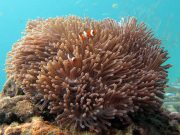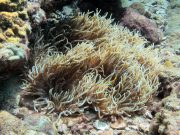Dykning med Anemoner i matta
Lanta Marina Liv | Stichodactylidae
Mattanemoner är en grupp rovlevande ryggradslösa djur som har fått sitt namn från den livfulla landblomman anemonen. Det finns mer än 1.000 arter runt om i världshaven på olika djup, de största och mest varierade förekommer i tropiska kustvatten. De finns i överflöd på alla platser på våra dykresor till Koh Lanta.
Anemoner är en nära släkting till koraller och maneter och är stickande polyper med en diameter på mellan 5 och 2 meter, med 10 till över 500 tentakler! De tillbringar sin tid fästa vid underlaget med en självhäftande fot, kallad Basal Disc. Deras kroppar är cylindriska med en rad tentakler som omger en central mun som också är deras anus. De äter plankton, småfisk och små kräftdjur som passerar. Minsta beröring utlöser tentaklerna, som skjuter harpunliknande trådar in i offret, injicerar ett förlamande nervgift och leder det hjälplösa bytet in i munnen.
Vissa djur har hittat sätt att utnyttja försvaret mot sig själva och har etablerat symbiotiska relationer. De mest kända symbiotiska allianserna är med anemonfiskar och porslinskrabbor. De täcker sig med slem som lurar anemonen att tro att de är en del av sig själv, vilket gör att de också är immuna mot sticket. Dessa partners lever inom tentaklerna, som ger skydd, och anemonen äter på resterna från deras måltider.
Vissa anemoner förökar sig genom lateral fission där ett identiskt djur växer ut från föräldern, bryter sig loss och blir självständigt. Många anemoner leker dock i vattnet där ägg och spermier blandas. Ungarna ansluter sig till planktonlagren och när de är tillräckligt gamla sätter de sig på ett substrat.
3 arter finns på denna sida:
Magnificent Sea Anemone
(Heteractis magnifica)

Heteractis magnifica @ Koh Rok
The Magnificent Sea Anemone is found attached to solid surfaces such as rock or dead coral and is found from the shallows to deeper water, usually in exposed areas where medium to strong currents can supply food.
The Magnificent Sea Anemone has a wide oral disc which can reach more than 50 cm across, but most often observed much smaller than this. The oral disc can open to a flat surface, is slightly wavy and is densely spotted with finger-line tentacles which are positioned in multiples of six (member of the six-part corals, Hexacorallia). The tentacles are 5 cm - 8 cm long with blunt or slightly bubble-like tips. The tips may be yellow, green or white.
The Magnificent Sea Anemone can have a variety of colours, with the Basal disc (sticky foot) and column being greyish, greenish or pinkish, purple or brownish. When disturbed, the oral disc will close, with only a few tentacles showing. In extreme cases of disturbance of a change in environmental factors, the Magnificent Sea Anemone can relocate.
Beaded Sea Anemone
(Heteractis aurora)

Juvenile Heteractis aurora @ Koh Bida
The Beaded Sea Anemone is easy to identify because of the numerous small bubbles or beads on each tentacle. In younger specimens, the beads are less developed and the tentacles are shorter, however as the tentacles grow, the beads develop into larger bubbles. Longer tentacles may have many dozens of beads or bubbles.
Since most of the tentacles are in the outer part of the anemone, the oral disc is relatively plain. There can be light brownish radial lines on the oral disc which extend into the sticky tentacles.
The underside of the oral disc and column can be grey-green to chestnut-brown. This anemone displays a variety of colours depending on the surrounding environment and the amount of zooxanthellae in the tissues.
This species can be host to several different species of anemonefish and also to the Three Spot Domino Damselfish (Dascyllus trimaculatus), however it is most commonly observed hosting Clarke’s Anemonefish (Amphiprion clarkii).
The Beaded Sea Anemone is often a temporary home for young clownfish on their journey to find a more suitable host anemone for adulthood, and is also known as a 'nursery' anemone.
Purple Tip Anemone
(Heteractis crispa)

Heteractis crispa @ Koh Bida
The Purple Tip Anemone, or Leathery Anemone, lives between corals and sand covered hardgrounds.
Colour can vary widely and depends on the amount of zooxanthellae in the tissues.
The body column is usually grey and the oral disk is often brownish violet or grey, but can also be bright green, occasionally with white stripes.
The Purple Tip Anemone has long, curled tentacles which become thinner toward the tip, and are positioned in concentric circles on the leathery oral disc. The oral disc and the tentacles have the same colour. The tentacle tips can often show a slightly different colour and may have a tiny purplish or greenish-blue spot at the tip center.
The Purple Tip Anemone can grow up to 30 cm in diameter and feeds mostly on products of its zooxanthellae.
This species is usually found among dead coral and rock rubble and lives in symbiosis with several different species of anemonefish and shrimp (genus Periclimenes).
Dykning med Anemoner i matta runt Koh Lanta
Dykning och Snorkelutflykter
Om du vill ha en chans att se Anemoner i matta på en av våra dagliga högsäsongs dykresor från Koh Lanta, skicka oss ett e-postmeddelande till info@diveandrelax.com.
Följ med på våra dykresor med speedboat under högsäsong till några av Thailands bästa dykplatser och njut av små grupper, korta restider och fokus på personlig service, säkerhet och nöje.
Är du ännu inte certifierad dykare? Lär dig att dyka på Koh Lanta med den 3-dagars SSI Open Water Diver-kursen.
Boka online och spara 10 % på dykresor och dykkurser på Koh Lanta.
Ta Reda på Mer
Guider för Marina Djur och Växter i Indo-Stilla Havet
- Allen, G., Steene, R., Humann, P., DeLoach, N. (2003) Reef Fish Identification, Tropical Pacific. Jacksonville, FL., USA: New World Publications, Inc., ISBN 1-878348-36-1.
- Humann, P., DeLoach, N., (2010) Reef Creature Identification, Tropical Pacific. Jacksonville, FL., USA: New World Publications Inc., ISBN 978-1-878348-44-9
- Debelius, H. (2013) Indian Ocean Reef Guide. Frankfurt, Germany: IKAN - Unterwasserarchiv, ISBN 978-3-939767-52-7.
- Debelius, H. (2004) Nudibranchs and Sea Snails, Indo-Pacific Field Guide. Frankfurt, Germany: IKAN - Unterwasserarchiv, ISBN 3-925919-51-1
- Erhardt, H., Knop, D. (2015) Corals Indo-Pacific Field Guide. Frankfurt, Germany: IKAN - Unterwasserarchiv, ISBN 3-925919-69-4.
- Veron J.E.N., Stafford-Smith M.G., Turak E. and DeVantier L.M. (2016). Corals of the World
